30.08.2025 by Viktor Siebert
Technical Summary Mitsubishi AC Spindle Motor SJ-11XW8Z
The SJ-11XW8Z arrived at our workshop during a complete retrofit of an aging CNC machine used for window frame manufacturing. The customer, focused on sustainable production, requested a full overhaul instead of a costly and wasteful replacement.
Although the motor was still running, inspection revealed clear signs of degradation:
- Layers of oil and dust on the housing
- Clogged cooling slots
- Aging and brittle seals
- Encoded signal errors under thermal stress
We disassembled the motor entirely, cleaned all parts using industrial-grade emulsions, and dried them in our heating cabinet. The bearings were replaced, seals renewed, and a new encoder was installed, programmed, and mechanically aligned.
The connectors were tested, the rotor balanced, and the motor received a fresh coat of paint before undergoing extensive testing:
- Idle run test
- Load simulation at 6000 rpm
- Temperature and noise checks
- Encoder signal jitter analysis
- Vibration check
The final result: a completely restored drive unit ready for the next years of reliable operation, at a fraction of the cost and resource consumption of a new unit.
Root Causes of Motor/Encoder Failure
- Thermal cycles → solder joint cracks
- Oil/fumes/moisture → corrosion, contact loss
- Vibration → loose contacts, bearing wear
- Aging → optical diode degradation in encoders
- Cable issues → insulation breaks, broken pins
Failures often develop gradually:
- Random signal losses
- Performance drops under load
- Repeated alarms
- Final complete failure
Preventive Advice for Users
- Keep the machine environment clean and dry
- Avoid large ambient temperature swings
- Inspect cables and connectors regularly
- Use vibration-dampening mounts
- Plan overhauls every 5–7 years
- Replace encoder preventively
- Monitor for unusual noises or heat buildup
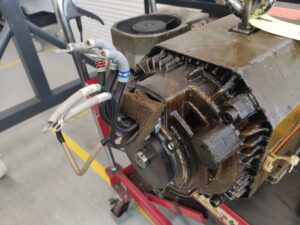
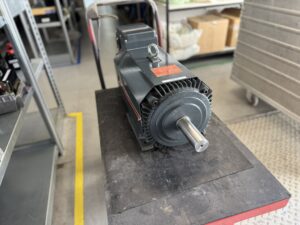
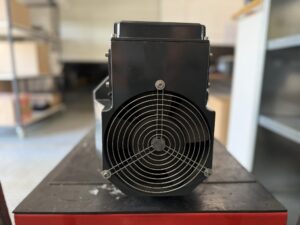
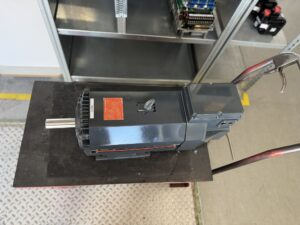
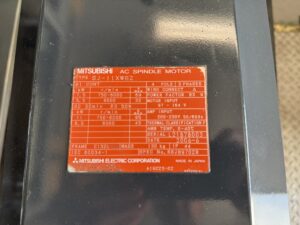
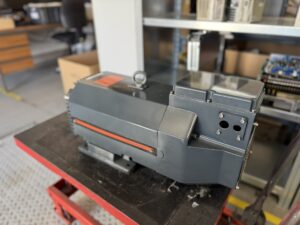
To mentioned Mitsubishi Motor: Mitsubishi AC Spindle Motor SJ-11XW8Z
More details about our Mitsubishi repair services can be found here:
Mitsubishi motor Repair by Industrypart
📞 Feel free to contact us with any questions about your Mitsubishi drive technology.
Our expert team is happy to help!
Device Data
| Specification | Value |
|---|
| Model | Mitsubishi SJ-11XW8Z |
| Rated Voltage | 200–230 V AC, 3-phase, 50/60 Hz |
| Continuous Output (S1) | 7.5 kW @ 750–6000 rpm / 5.5 kW @ 8000 rpm |
| Intermittent Ratings | 11 kW (30 min), 8 kW (S3 50 %) |
| Max Current | up to 95 A depending on load condition |
| Motor Input Voltage | 97–164 V |
| Power Factor | 83 % |
| Winding Connection | Delta (Δ) |
| Number of Poles | 4 |
| Protection Class | IP44 |
| Insulation Class | F |
| Ambient Temperature | 0–40 °C |
| Frame Size | G132L |
| Weight | Approx. 130 kg |
| Manufacturing Date | 2006-06 |
Application & Compatible Systems
This spindle motor is typically used in:
- CNC routers for wood and aluminum
- Vertical machining centers
- Industrial window frame production lines
- High-speed milling machines in furniture or plastics sector
Compatible drives include:
- Mitsubishi FR‑S500P
- Mitsubishi FR‑SF‑4‑7.5KP
- MDS‑B‑SP‑185 (configuration dependent)
Functional Description
The SJ-11XW8Z is a high-speed asynchronous AC spindle motor, designed for continuous operation in demanding environments. Its durable construction and precise encoder feedback make it well-suited for tasks requiring stability, longevity, and thermal resilience.
Features include:
- High-speed operation up to 8000 rpm
- Heavy-duty continuous load capability
- External encoder for closed-loop control
- Aluminum housing with IP44 protection
- Designed for integration in complex CNC systems
Alarms & Troubleshooting (MDS-B-SP-…. Mitsubishi Spindle Drive)
| Alarm | Name | Description | Cause | Solution |
|---|
| 12 | ME1 – Memory Error | Memory or checksum error on spindle control card | ROM/RAM issue | Replace or reprogram control board |
| 13 | SWE – Software Error | Software process did not finish in time | Firmware failure or startup issue | Firmware update or card replacement |
| 17 | ADE – AD Converter Error | Current detection ADC failed to initialize correctly | AD circuit fault | Inspect and replace AD components |
| 21 | NS2 – No Encoder Signal | Signal from spindle encoder missing or abnormal | Encoder cable break, encoder damage | Check/replace encoder and cables |
| 23 | OSE – Excessive Deviation | Excessive deviation between commanded and actual spindle speed | Load mismatch, tuning issues | Adjust parameters, verify mechanical setup |
| 31 | OS – Overspeed | Motor exceeded maximum speed threshold | Misconfigured parameters or encoder malfunction | Adjust limits, inspect encoder |
| 32 | PMOC – Power Module OC | Overcurrent detected in power module | Short circuit or faulty IGBT | Replace power board, inspect motor |
| 34 | DP – CRC Communication | CRC error in data received from NC | Noise, communication interference | Check cable shielding and data integrity |
| 35 | DE – Data Error | Invalid movement command from CNC | Timing or command structure issue | Verify NC program or synchronization |
| 36 | TE – Transmission Error | CNC command transmission aborted | Communication line break | Inspect/repair signal cables |
| 37 | PE – Parameter Error | Unacceptable value set in parameter configuration | Incorrect settings or data corruption | Reset or correctly configure parameters |